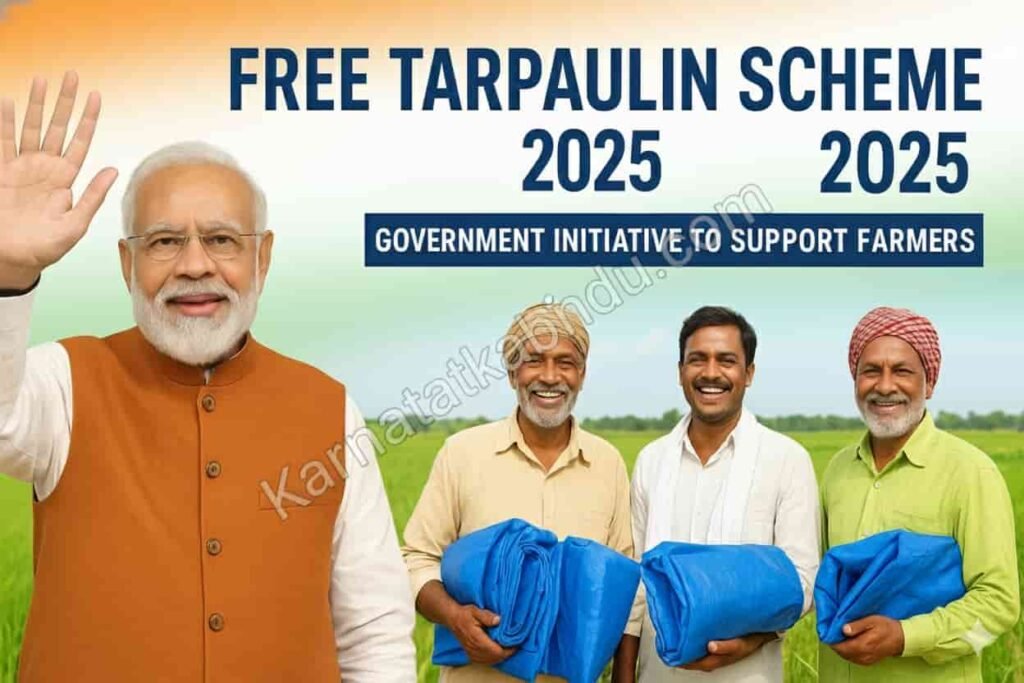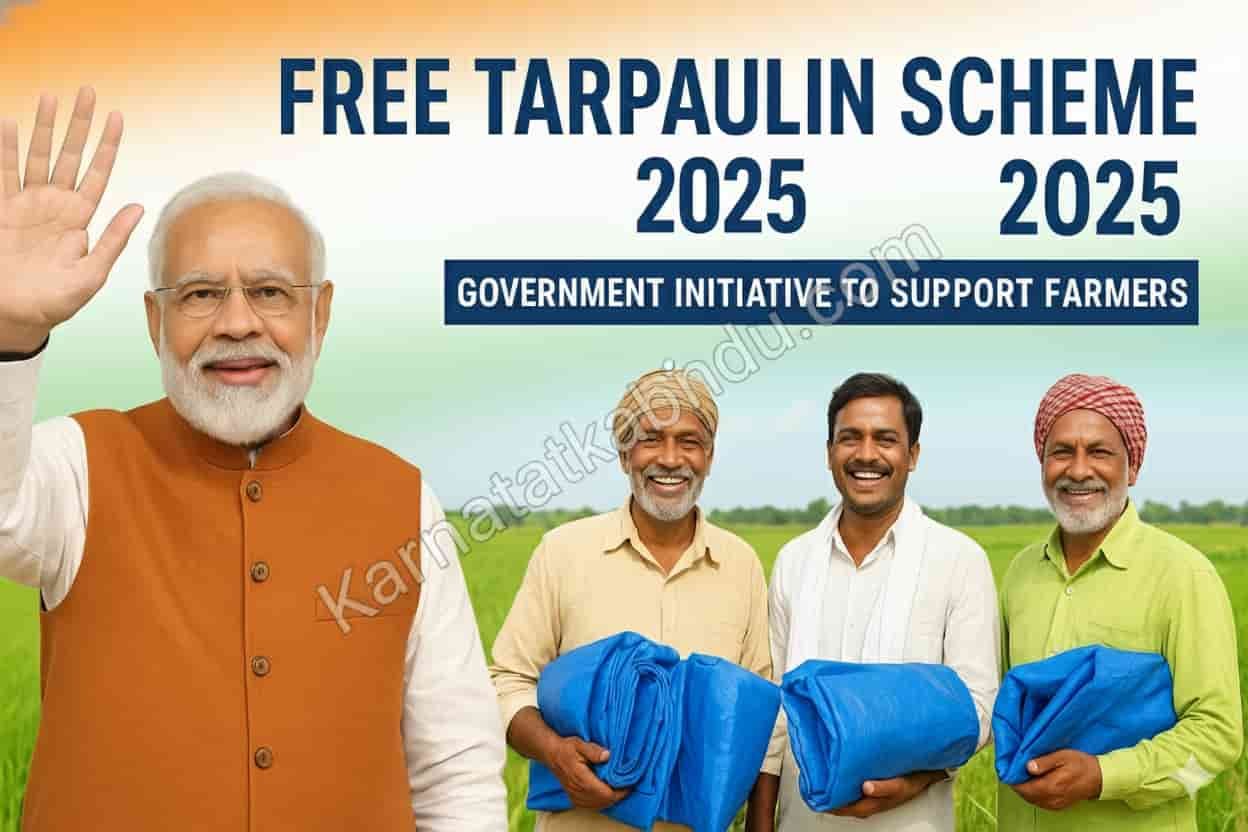Around the world, rural communities face weather risks that can damage crops, livestock shelters, and homes. In India, farmers and economically vulnerable families often lack access to affordable protective materials such as tarpaulins (plastic sheets) that can shield against rain, storms, and sun. Recognizing this gap, some state governments are proposing or implementing Free Tarpaulin Schemes in 2025 to help farmers and low-income households. This article explains what these schemes are, who qualifies, how they work, benefits, challenges, and how you can apply.
What Is a Free Tarpaulin Scheme?
A Free Tarpaulin Scheme is a public welfare initiative in which the government distributes tarpaulin sheets free of cost (or heavily subsidized) to farmers, households, or institutions that need temporary or semi-permanent coverage. These plastic sheets can be used for:
- Covering harvested crops or grain stacks
- Roofing for sheds, cattle sheds, or temporary farm structures
- Protecting soil, seeds, or produce from rain and weather
- Emergency shelter or housing repairs in rural areas
The goal is to reduce losses from weather damage, help farmers preserve their outputs, and provide relief to households that cannot afford to purchase good quality tarpaulin materials.
Some versions of the scheme may also include accessories like ropes, nails, or installation assistance.
Why a Tarpaulin Scheme Matters in 2025
Weather Volatility and Increasing Risks
Climate change has brought more erratic weather — sudden heavy rains, longer dry spells, hailstorms, and unseasonal storms. For farmers with limited infrastructure, such sudden events can wipe out large portions of produce or damage storage. A helping hand in the form of protective materials (like tarpaulins) can reduce that vulnerability.
Cost Barriers for Poor Households

High-quality tarpaulin or plastic sheets are not too expensive per se, but for marginal farmers or very poor families, buying enough to cover even a small area can strain their budgets. A scheme that offers them free or subsidized coverage helps reduce that barrier.
Agricultural Productivity & Post-Harvest Loss Reduction
Often, a significant portion of produce is lost in storage or transport due to rain, moisture, or spoilage. Tarpaulin sheets help preserve harvested items until they can be sold, thus improving farmers’ incomes and reducing waste.
Disaster Relief & Resiliency
In flood, storm, or drought-prone areas, distributing tarpaulins quickly helps affected families repair temporary roofs or protect their belongings. It adds to community resilience.
Who Can Benefit? Eligible Recipients
While the exact eligibility criteria vary by state and scheme, typically the following groups are targeted:
- Marginal and small farmers (those holding small land parcels)
- Tenant farmers who do not own land but cultivate
- Low-income households in rural or peri-urban areas
- Tribal communities or people in remote regions
- Families affected by recent natural disasters
- Cooperatives, farmer groups, or community institutions in some versions
Usually, the eligibility will require proof like land records, Aadhaar, income certificate, or survey registers listing BPL (Below Poverty Line) households.
Some schemes may prioritize families with very limited means, households in backward or hilly areas, or those with recent losses due to weather.
Key Components and How the Scheme Works
Here’s an outline of how a typical tarpaulin distribution scheme may be structured:
1. Announcement & Budget
The state or central government announces the scheme, allocates a budget, and defines guidelines (quantity, size, quality standards, eligible groups).
2. Application & Verification
Interested farmers or households submit applications with the required documents (land records, identity proof, address, income proof). Government or local agriculture/ Panchayat offices verify the claims.
3. Allocation & Procurement
Based on verified applications, the government procures tarpaulin sheets (often in bulk) from approved manufacturers to ensure quality.
4. Distribution
The sheets are distributed at designated collection points (gram panchayat offices, block offices, or local distribution centres). Beneficiaries receive them free or at subsidized cost.
5. Usage & Monitoring
Beneficiaries must use the tarpaulin for the intended purpose (e.g. farm, storage, roof). The government may follow up with on-site checks, usage monitoring, or audit visits to ensure appropriate usage.
In some schemes, there may also be funds or support for assisting in installation, ropes, nails, or providing technical advice.
6. Grievance Redress & Feedback
A system should ideally exist where people can report non-receipt, substandard material, or misuse of the scheme.
Benefits of the Free Tarpaulin Scheme
When implemented well, such a scheme can deliver multiple benefits:
Reducing Crop & Produce Loss
Protecting harvested crops or grain from rain, moisture, and pests helps preserve yield and reduces losses.
Lowering Input Risks
Farmers can store inputs (seeds, fertilizers) safely without fear of spoilage due to weather damage.
Financial Relief for Vulnerable Households
Providing this material free reduces expenditure burden on low-income families, especially in lean months or post-harvest cycles.
Strengthening Resilience
In areas prone to storms, floods, or unexpected weather, tarpaulins help families protect roofs or structures—giving them a buffer during crises.
Boosting Confidence & Moral Support
Such schemes show the government is supporting its rural population, which builds trust and morale. It also encourages farmers to invest, knowing they have at least one safety net.
Challenges & Caveats
A well-meaning scheme faces various implementation difficulties and risks. Here are some to be wary of:
Quality & Durability
If the government procures low-grade plastic sheets, they may tear or degrade quickly under sun or wind. That defeats the purpose. Ensuring proper thickness (measured in microns), UV stabilizer, and durability is crucial.
Leakages & Misuse
Some beneficiaries might procured sheets and resell them, or misuse them for non-intended purposes. Monitoring and audits are needed to reduce diversion.
Logistical Constraints
Transporting bulky tarpaulin rolls to remote villages, storing them securely, and distributing them without damage is logistically complex.
Under-Reporting & Exclusion
Vulnerable households often lack formal documentation, which might exclude them. Ensuring inclusive application and relaxing documentation for the poorest can help.
Timely Delivery
If the sheets arrive after monsoon or once the damage is done, they lose relevance. Timeliness is vital.
Maintenance & Replacement
Plastic degrades over time. Unless replacements or repairs are allowed, beneficiaries might suffer once the sheets start deteriorating.
What to Check Before Applying
If you plan to apply or benefit from such a scheme, here are some pointers to check:
- Scheme notification: Read the official government circular or notification for complete terms, eligibility, and dates.
- Quality specifications: Check the thickness (micron rating), UV protection, manufacturer standards.
- Required documents: Proof of identity, land records, income certificate – check whether alternate proofs are acceptable.
- Distribution locations: Where and when distribution will happen.
- Support services: Whether there is help for mounting/installing the sheets, nails, ropes, etc.
- Grievance redress: Contact numbers or portals to report non-receipt or defects.
How to Use Tarpaulin Correctly
To get the most value from your free tarpaulin, use it wisely:
- Make sure the sheet is stretched taut and secured properly with ropes to avoid wind tear.
- Use wooden or bamboo support frames so the tarp does not sag and collect rainwater.
- Always provide drainage or slope so water does not pool.
- Repair holes immediately using a patch and sealant.
- Store the sheet when not in use, avoid prolonged sun exposure when idle.
- Use over existing structures (e.g. shed roof) to reinforce, not as bare roofs.
Sample Scheme Outline (Hypothetical State)
Here’s a possible template of how a state-level tarpaulin scheme in 2025 might look:
| Item | Detail |
| Eligibility | Marginal / small farmers; BPL households; disaster-affected families |
| Quantity per family | 1 roll (e.g. 4 m × 6 m sheet) |
| Quality standard | 200–250 micron UV-stabilized tarpaulin |
| Distribution mode | Free at Grama Panchayat or Block Office |
| Application period | June – July (before monsoon) |
| Documents needed | Aadhaar, land record / ration card, income certificate, photo |
| Install support | Optional rope, nails, or local carpenter assistance |
| Monitoring | Local Panchayat verification + follow up visits |
How to Apply / What You Should Do
Here’s a suggested step-by-step plan (you may adapt based on your state):
- Watch for announcements from your state agriculture or rural development department (newspaper, radio, local offices).
- Obtain the application form at the Panchayat, block office, or online portal (if available).
- Fill in your details: name, address, landholding, income, identity proof, etc.
- Submit required documents (Aadhaar, land certificate, income proof, etc.).
- Get verified by local official (e.g. Panchayat or agriculture extension officer).
- Wait for allocation notice — approved beneficiaries will be notified.
- Collect tarpaulin when distribution happens — often block-level or local offices.
- Use & maintain – install properly, keep in good condition.
- Raise complaint / grievance if there is any omission, damage, or poor quality.
Case Studies & Anecdotes
- In one village, a group of small farmers used government-supplied tarpaulin to cover grain stores during unexpected rains, which saved up to 25 % of produce that would otherwise have been damaged.
- In a flood-hit area, families used the sheets to repair damaged roofs temporarily, ensuring that their homes weren’t fully exposed until permanent repairs could be made.
These stories illustrate how a relatively small material intervention can avoid big losses.
State-Wise Possibility & Variations
Different states may adapt the scheme to local needs:
- Hilly regions may receive thicker, more durable sheets to deal with snow or heavy rain.
- Coastal areas might have corrosion-resistant tarpaulin variants for saline environments.
- Tribal blocks may have relaxed documentation norms.
- Disaster-response mode schemes may offer rapid deployment to affected villages immediately after floods or storms.
Potential Long-Term Impacts
- Improved farmer income due to fewer losses.
- Reduced wastage in agricultural value chains.
- Greater resilience in climate-vulnerable zones.
- Strengthened trust between government and rural citizens.
- Better food security in communities by preserving more of harvested produce.
Apply link
✅ Click here ✅
Conclusion
A well-designed Free Tarpaulin Scheme can be a simple but powerful tool to support farmers and low-income families. By distributing quality tarpaulins free or at subsidized cost, governments can protect vulnerable populations from weather-induced losses, boost agricultural productivity, and strengthen rural resilience.
